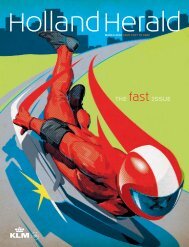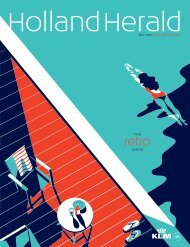january-2012
january-2012
january-2012
Create successful ePaper yourself
Turn your PDF publications into a flip-book with our unique Google optimized e-Paper software.
the gay section near Posto 8, and next to Copacabana Beach,<br />
you fi nd Posto 7, the surfi ng area. “Posto 10 is probably the most<br />
laid back area,” Tião laughs. “Th is is the lazy section.”<br />
Down on the sand, four quick-fi re volleyball games are<br />
underway, and a group of men are playing beach football. Th e<br />
cycle track behind me is thick with cyclists, skaters,<br />
skateboarders, joggers and speed-walkers. Tião smiles as he<br />
reads my thoughts. “Well, they do say that Ipanema’s the<br />
healthiest beach in the world...” he says.<br />
From sunrise to sunset, Ipanema is a permanent procession<br />
of sporty-looking bodies. At times, the promenade here could<br />
almost be a conveyor belt out of some utopian factory dedicated<br />
to the creation of the perfect body.<br />
Apart from people-watching, one of the most spectacular<br />
sports on Ipanema is futevolei (or foot-volley). It was created as a<br />
reaction to a law against soccer on the beach in the early 1960s;<br />
the players would use the ‘camoufl age’ of a volleyball court to<br />
avoid the police.<br />
Players compete in pairs, and the ball is kept in play using<br />
any part of the body apart from the hands and arms. On<br />
Ipanema, you can see both men and women exhibiting a level of<br />
skill that is rarely seen even across town in Rio’s historic<br />
Maracanã stadium.<br />
Of course, there are many who prefer simply to relax. Th ey<br />
rent parasols and buy provisions from barraqueiros, the (oft en<br />
elderly) ‘beach-boys’ who sell traditional Globo biscuits and<br />
refreshing maté tea. Men dressed in Arabic costumes shuffl e<br />
through the sand selling little triangles of meat-stuff ed esfi ha,<br />
similar to somosas. Fift y-three year old Januário sells other<br />
triangles: “Bikinis of all sizes,” he says, “right from minimangoes<br />
up to triple-handful.”<br />
His friend Antonio has spent half his life patrolling Ipanema’s<br />
iconic black-and-white pavements selling his cangas (sarongs).<br />
“So many people come here running and cycling…” he says,<br />
“but I have probably covered more miles of Ipanema than<br />
anyone alive.”<br />
Th ere is very little that happens on the beach that Antonio<br />
and Januário don’t know about. Th e waitresses in the beachside<br />
kiosks, serving caipirinha cocktails round-the-clock, call them<br />
the unoffi cial mayors of Ipanema.<br />
This picture-perfect patch is only eight blocks long, and is<br />
bordered on three sides by water: the sea, the lake and the<br />
adjoining river. On the fourth are the rocks that separate it from<br />
Copacabana. Ipanema might be part of a city that is seven<br />
million strong, but it’s also one of the most privileged villages in<br />
the world.<br />
52 Holland Herald

















